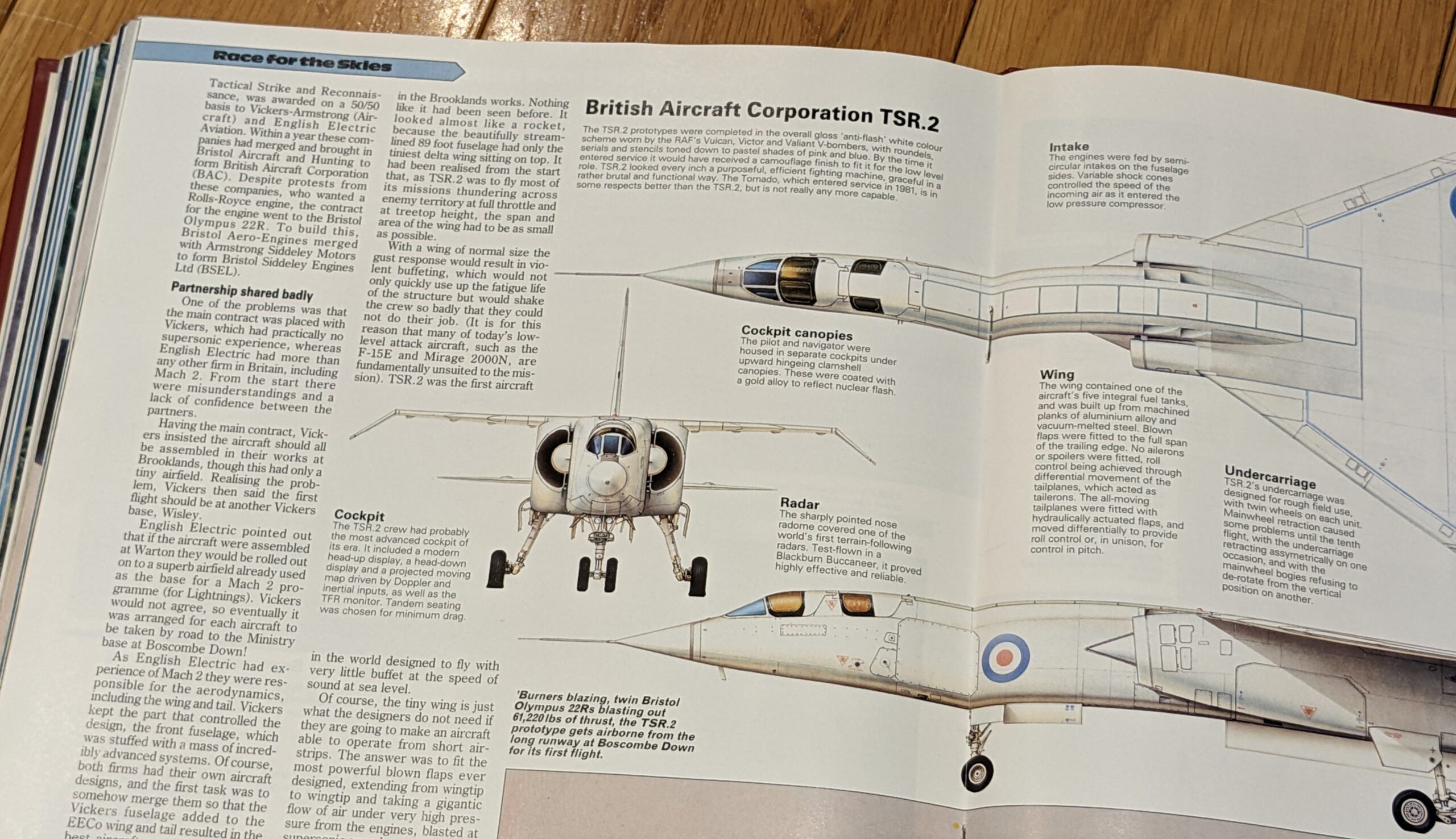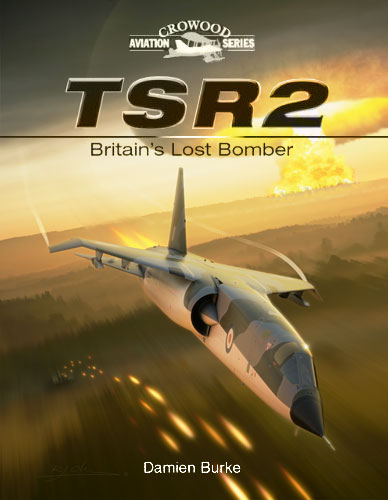Read: TSR2: Britain’s Lost Bomber, Damien Burke
I had always been interested in the story of the TSR2 (Tactical Strike Reconnaissance) aircraft ever since I read about it in an old copy of Take Off magazine a long time ago. It was a story shrouded in faded grandeur, a tale of brilliant and far-sighted engineering defeated by mucky politics, parsimonious accountants and meddling bureaucrats. The fabled aircraft that never was.
The author certainly didn’t pull any punches, one image is tagged with:
“Had it not been murdered by the politicians, TSR.2 would have been in frontline service to this day”
Take Off issue 11, p301

So I always wanted to know more about this wonder plane that never was, and I was delighted when I found Damien Burke’s book on Kindle.
It’s a fascinating read, thoroughly researched, full of deep and intricate detail. It follows the story from the issuing of the initial General Operational Requirement (GOR.339) that specified the need for a new strike aircraft, through the twists and turns of development to the final cancellation. It covers the alternative submissions made to the GOR from all the varied interested parties, all of whom were eager to secure a contract that would enable their company to survive. From Avro to Barnes Wallis, there were an array of options presented, some more practical than others, some looking like they’re from Thunderbirds are Go!

The detailed story is far more complex and more interesting than the mytholgised edition, which like most myths, glosses over a lot. As with any complicated project involving many people and lots of money, it’s not a simple story and at 906 pages, the author doesn’t shy away from any of the intricate details. There was also a lot riding on it, the military world went through a lot of changes from the time the need was identified through to the test flights.
Part of the difficulty that the TSR.2 project had was that it was conceived at a time of great change and uncertainty. The Canberra, coming from a specification issued in 1945 and equipped with two jet engines, had just reached service as a tactical bomber. Capable of reaching 930km/h or about 88% of the speed of sound, it was to serve in the role that the Mosquito bomber had made it’s own during the Second World War – high speed ‘medium’ bomber (what would become known as a tactical strike role in more modern parlance). The Mosquito, powered by two piston engines, could reach 668km/h, and came from design work of the late 1930’s into 1941. The TSR.2 requirement was for a twin-jet engine craft capable of twice the speed of sound at height and 1.2 times at low level (over 1,200 km/h).
It was also realised that in the coming years, and no later than the mid-60’s, surface to air missiles would render high level bombing a thing of the past, and the Canberra (and the entire V-Bomber strategic force) was a high-level bomber. To penetrate the Warsaw Pact air defences would require low level, high speed flights that stuck as close to the ground as possible, popping up just before the target in order to drop an atomic bomb and escape from the blast radius. This would require an entirely different type of aircraft. The V-Bombers could go low level, but they weren’t built for it, and the resulting fatigue would render them unservicable pretty fast:
By [early 1963] the V-force was on its last legs in terms of being able to penetrate Soviet defences successfully, and would have to shift to low-level operations. An RAF study, however, found that low-level operations would reduce the 3,130hr fatigue life of an Avro Vulcan B.1A to a mere 270hr, and wear the aircraft out entirely within just three years if strengthening modifications were not made. Handley Page Victors would fare rather better, but it was clear that the V-force as a whole was not going to last long.
TSR.2, page 257
The military strategy of the time, and on into the 1960’s, was that of a tripwire – any war would go atomic immediately. All that could be done was to launch a massive strategic retaliation before the Warsaw Pact armies reached the Rhine. Essentially, the Russians were too powerful conventionally, the only way to stop them was with atomic bombs (and soon the even more terrifying fusion weapons), so the plan was to do so in the event of the unthinkable happening. This created it’s own relentless logic – if the plan was to go nuclear immediately, then there was no point in maintaining huge conventional armies of expensive people – so cuts could and were made to the ground forces. Likewise in the air – what was the point in having many long range interceptor fighters and tactical strike aircraft if the retaliation was to be instant and massive? This gave rise to the incredibly speedy fast climbing Lightning, which had a remarkably short range – it’s sole purpose was to prevent sneak attacks by Russian bombers against the airfields of the V-Force before the V-Bombers could take off.
This logic played into the notorious UK 1957 Defence White Paper, that suggested all air defence could be done by missiles and what was the use of manned aircraft at all? While it caused uproar in the British aviation industry and the RAF, it can be seen as the logical outcome of the defence thinking of the time. Indeed, the Joint Intelligence Committee released a report in 1955 showing that just 10 Russian hydrogen bombs of 10 megatons each “delivered on the western half of the UK or in the waters close in off the Western seaboard […] would [..] make normal activity completely impossible” (The Secret State, Peter Hennessy, p153). What would be left to defend with fighters or where would the tactical aircraft fly back to? (Of course, the thinking changed but by then it was too late for the TSR.2 and many other aircraft projects that may or may not have been of any use – the author can’t see the Fairey Rotodyne as having been brought into use anywhere at any time, and neither can I. The noise levels were too high, even for the 60’s or 70’s, and few jets from that time are allowed fly into commercial airports due to the noise of the older, low-bypass engines).
The book also contains a mass of detail regarding the consolidation of the multiplicity of manufacturers in the UK at the time, prompted by the government who could see that many relatively small operations would not survive now that aircraft were becoming more complex and expensive. Other countries went through the same consolidation process and continued to produce widely sold and successful aircraft like the French Dassault Mirage III, yet, in the UK it seems to have been far more difficult and indeed the UK motor vehicle industry suffered from similar issues. There, it lead to a setup where rather than one company building the TSR.2, several got the contract or parts thereof and there were also a number of subcontractors involved. The overhead and frustration of managing this is revealing and the author details several examples of the delays and costs that resulted.
[George Edwards, Vickers-Armstrongs] did not deny that BAC had substantially failed to keep its promises to improve slippages and keep control of costs, but he blamed it all on the ridiculous enforced amalgamation of two companies with separate cultures, procedures, staff and production locations. Furthermore, the main reasons for BAC’s failures to keep to production schedules were delays in construction of the wings and the rear fuselages; the work carried out by English Electric at its factories. In fact, one particular fuselage frame had been giving English Electric severe trouble, and they had to take inhouse the work on the tailplane spigots when a subcontractor could not handle the job satisfactorily. The company also had a culture of individual factories working to their own methods, rather than pulling together as part of a single organization. Friction between designers and production departments was all too common, frequent changes in drawings driving the production side up the wall.
TSR2, p260
By the time the new UK Labour government came to power in 1964, the first TSR.2 was still not ready for production and it was cancelled, thus ending the story. It cost too much, and it wasn’t good enough either. A revealing view on both counts is given in the book Empire of the Clouds by James Hamilton-Paterson where in an interview (p240) with John Farley, a test pilot of the time, he reveals that the system:
operated on a Cost-Plus basis. The idea was that we [in the industry] spend money, we do research, we do development, we give you [the taxpayer] the receipts, you pay the bill – and then you give us a percentage on top as profit … This was a ludicrous way to run an aircraft industry. [ … ] And in order to get the spending back under control the Labour Government [ … ] cancelled the lot.
Empire of the Clouds, James Hamilton-Paterson, p240, italics original
This interview goes on to detail the technical reasons for cancellation as John Farley saw them – too little wing, too little maneuverability, and as a result too vulnerable to opposition fighters and missile attack.

All in all, a fascinatingly detailed and in depth look at the life of an aircraft from conception through design, build and testing. As to the myth, well, I consider it busted. The TSR2 wasn’t ‘murdered by politicians’, it was brought down by it’s own limitations and sheer cost. As the author puts it himself:
While the author enjoys a good polemic aimed at politicians as much as the next man, the available evidence points only to sheer cost as the reason. No government could have held out for long before either cancelling or further downgrading the specification, and TSR2 was already too expensive to survive as a downgraded weapons system. Had the project continued any longer, it could well have bled both BAC and the RAF dry
TSR2, p761

